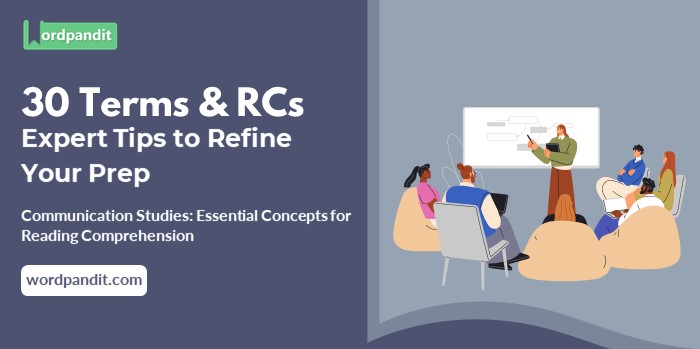📋 Communication Studies: Essential Concepts for Reading Comprehension
Communication is the backbone of human interaction, influencing how we exchange ideas, solve problems, and share experiences. For GMAT and CAT Reading Comprehension (RC) passages, understanding Communication Studies is crucial for analyzing arguments, identifying underlying issues, and grasping the nuances of written discourse. Passages touching upon communication often involve critical issues such as media ethics, cultural exchange, and digital connectivity, making these concepts indispensable for test-takers.
📋 Overview
In this guide, we’ll explore these key Communication Studies-related concepts:
- Interpersonal Communication
- Mass Communication
- Communication Theories
- Digital Communication
- Nonverbal Communication
- Intercultural Communication
- Organizational Communication
- Media Literacy
- Rhetoric
- Communication Ethics
🔍 Detailed Explanations
1. Interpersonal Communication
Interpersonal communication refers to the exchange of information between individuals, whether verbal or nonverbal. It shapes personal relationships and reflects emotional, social, and cultural dimensions. Interpersonal communication is context-sensitive and depends on factors like tone, body language, and the relationship between the communicators.
- Involves direct interaction between individuals.
- Can be verbal (spoken or written) or nonverbal (gestures, expressions).
- Context and cultural background play crucial roles.
- Foundational for resolving conflicts and building relationships.
- Explores concepts like empathy, active listening, and feedback.
Explained Simply: Think about how you talk to your best friend versus your teacher. You might use funny jokes with your friend, but with your teacher, you speak politely. This is called interpersonal communication—changing how you talk and behave depending on who you’re talking to!
2. Mass Communication
Mass communication involves transmitting information to large audiences through media like newspapers, television, and the internet. It’s a one-to-many form of communication, aiming to inform, persuade, or entertain.
- One-to-many communication through media platforms.
- Covers journalism, advertising, and entertainment.
- Central to shaping public opinion and cultural trends.
- Raises questions about media ethics and misinformation.
- Explores technological advancements in content dissemination.
Explained Simply: Imagine a giant loudspeaker telling everyone in the city the same message at once! That’s like mass communication. Instead of a loudspeaker, we now use TV, newspapers, and social media to send messages to lots of people.
3. Communication Theories
Communication theories provide frameworks for understanding how information is sent, received, and interpreted. Models like Shannon-Weaver’s Communication Model explain processes like encoding, decoding, and noise. These theories help RC readers analyze passages discussing how communication succeeds or fails.
- Frameworks explaining the process of communication.
- Includes theories like sender-receiver models and agenda-setting.
- Focuses on how messages are encoded, sent, and interpreted.
- Explores barriers like noise and miscommunication.
- Foundational for analyzing effectiveness in communication.
Explained Simply: Think of it like a game of telephone! You whisper a message to your friend, they whisper it to someone else, and sometimes the message changes because of mistakes or noise. Communication theories study why this happens and how to fix it.
4. Digital Communication
Digital communication involves the exchange of information through electronic platforms like email, social media, and instant messaging. This form of communication has revolutionized how people connect globally, making it faster and more accessible.
- Involves electronic channels like social media, email, and apps.
- Revolutionizes global connectivity and speed of interaction.
- Raises concerns about data privacy and misinformation.
- Key to understanding debates on technology’s societal role.
- Explores both benefits (efficiency) and challenges (cybersecurity).
Explained Simply: It’s like sending a message in a bottle, but the bottle travels instantly through your phone or computer! You can talk to someone on the other side of the world in seconds—that’s digital communication!
5. Nonverbal Communication
Nonverbal communication refers to conveying messages without words, using gestures, facial expressions, posture, and tone of voice. It’s a universal language that adds depth to interpersonal communication.
- Involves gestures, expressions, and body language.
- Enhances or contradicts verbal communication.
- Universal yet influenced by cultural norms.
- Crucial for understanding social interactions.
- Helps interpret underlying emotions and intentions.
Explained Simply: Imagine you smile at a friend—it shows you’re happy without saying anything. Or, if you cross your arms, it might show you’re upset. That’s how we “talk” without words!
6. Intercultural Communication
Intercultural communication focuses on the interaction between people from different cultural backgrounds. It emphasizes understanding differences in values, beliefs, and communication styles.
- Explores communication across different cultures.
- Focuses on cultural values, norms, and communication styles.
- Vital for understanding globalization and diversity.
- Explores conflicts and solutions in multicultural settings.
- Enhances empathy and cultural sensitivity.
Explained Simply: It’s like learning a new game with different rules. When you play with kids from another country, you might need to learn how they play and share your rules too. That’s intercultural communication!
7. Organizational Communication
Organizational communication deals with how information flows within and between organizations. It examines hierarchical structures, team dynamics, and leadership styles.
- Studies how communication happens within organizations.
- Covers leadership, team collaboration, and decision-making.
- Examines hierarchical versus flexible communication models.
- Relevant to workplace ethics and corporate culture.
- Helps in analyzing efficiency and conflict in professional settings.
Explained Simply: Think of a school play. The teacher tells the director what to do, the director guides the actors, and everyone works together to make the play great. That’s like communication in an organization!
8. Media Literacy
Media literacy is the ability to critically analyze media messages, recognizing biases, intentions, and credibility. It’s a vital skill for understanding RC passages that explore the role of media in shaping public opinion and culture.
- Teaches critical thinking about media messages.
- Identifies bias, intent, and accuracy in media.
- Explores the impact of advertising, news, and entertainment.
- Relevant in analyzing the influence of media on society.
- Helps readers navigate misinformation and propaganda.
Explained Simply: Imagine watching a magic trick on TV. Media literacy helps you figure out how the trick works, so you’re not fooled!
9. Rhetoric
Rhetoric is the art of persuasive communication. It examines how language is used to influence, argue, or inspire.
- Studies the use of language to persuade or influence.
- Covers ethos (credibility), pathos (emotion), and logos (logic).
- Explains how arguments are constructed and presented.
- Central to analyzing persuasive or argumentative passages.
- Foundational for critical thinking and debate analysis.
Explained Simply: It’s like trying to convince your parents to buy you a toy—you might say, “I’ll do all my homework” (logic) or “This will make me so happy” (emotion). That’s rhetoric!
10. Communication Ethics
Communication ethics examines the principles guiding honest and respectful exchanges of information. It addresses issues like misinformation, privacy, and fairness.
- Focuses on honesty, transparency, and respect in communication.
- Examines issues like privacy, bias, and misinformation.
- Relevant in debates on free speech and media accountability.
- Encourages responsible communication in professional and personal contexts.
- Foundational for ethical decision-making in communication.
Explained Simply: It’s like playing a game where everyone has to follow the rules and be fair. If someone cheats or lies, it’s not fun for anyone. Communication ethics are like the rules of talking and sharing honestly.
✨ Conclusion
Understanding Communication Studies equips you to interpret RC passages with clarity and precision. These concepts help you grasp arguments about media, cultural exchange, or ethical debates. By mastering these ideas, you’ll not only excel in RC sections but also sharpen your critical thinking for real-world applications.

